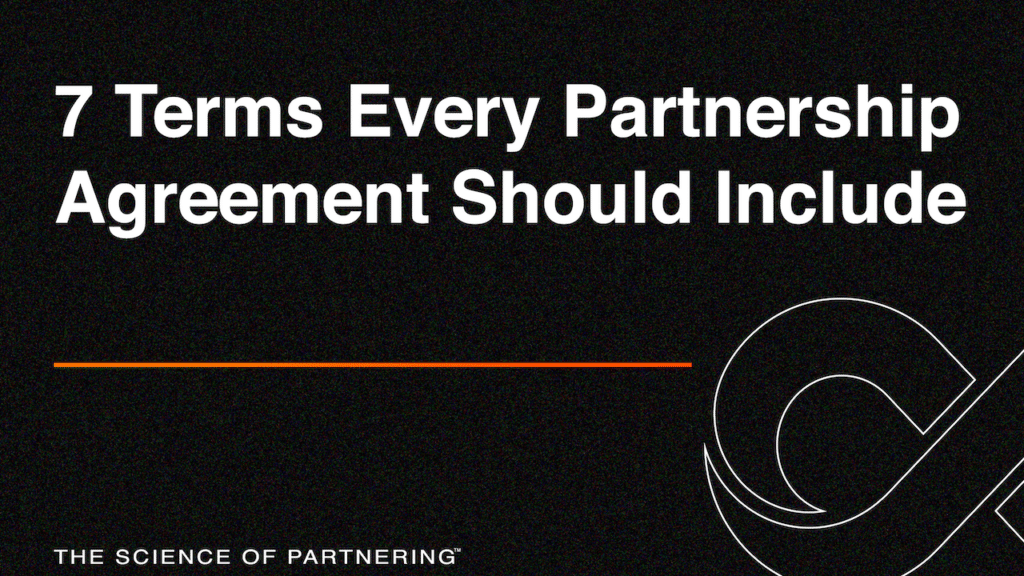I have always said, “Contracts do not make partnerships–leaders who share a common vision and commitment for a better future make partnerships!” The best partnerships deliver compelling value to all participants, partners and customers. Unlike Master Services Agreements (MSA), strategic partnering agreements do not have a purchase order tied to the contract execution. In fact, almost every strategic partnership that I have negotiated or led had a revenue share component and no guaranteed payment.
Revenue Share
Revenue share relationships are structured in a way that allows each party to be compensated based on the risk, resources, and results they contribute. Under this arrangement, there typically are no payments made between partners unless the value is created. Sales teaches “ABC – always be closing.” And partnering teaches, “ABCV – always be creating value!”
Revenue sharing arrangements can be quite creative. For example, if your partner is providing relatively high value in early years, you can offer them an increased amount in early years that reduces over time. For example, your partner could receive 60% in year 1, 50% in year 2, and 40% thereafter.
You can also have performance based tiers. For example, you may implement a structure that provides a 50% share if total revenue is between $0-1 million, 40% share if total revenue is between $1-2 million, and 60% share if total revenue is above $3 million.
Similar to most company’s internal sales teams, you should consider financial incentives to foster the performance that you want, including accelerators. Structuring strategic partnerships to pay based on a revenue share will provide incentive to produce future sales while simultaneously mitigating risk because your company will only pay if revenues are received. These arrangements move your costs from fixed to variable which is very attractive for new and unproven initiatives.
One Time & Fixed Payments
In addition to revenue share arrangements, there are additional options to consider. For example, agreements may include an upfront investment or a minimum monthly financial commitment from one party to the other. Think of this arrangement as seed and/or growth capital.
I have seen many examples where a larger company agrees to provide an infusion of dollars in order to fund or accelerate development of a strategic solution. Even in these fixed revenue cases, they frequently include a revenue share component as well. It all comes down to providing incentives and mitigating risks.
Value Beyond Direct Revenue
Value can be presented in many forms when considering strategic partnerships. One form that can be significant, especially to startups, is the publishing of a press release. Landing a deal with an industry titan is not easy to do, but their market power can transcend to significant revenues for your growing company. If a press release can offer value to your company, be sure to address the topic in your partnership agreement.
It is also smart to discuss co-marketing and co-branding efforts with prospective partners. As your new “growth engine” hits the market, you will likely be spending considerable resources to market the new solution. By forming a co-marketing arrangement with your partner, you will have an opportunity to share in the cost of evangelizing the joint endeavor.
Co-branding is another effective way to increase the value and equity of your organization through a partnership. A company’s brand is the most valuable asset that it owns. Since you are looking to partner with industry leaders, your partner candidates should have brands with which your company will want to be associated. By engaging in co-branding efforts with stellar partners, your brand’s equity will get a lift, so take advantage of this great opportunity.
Exclusivity
Exclusivity can be a powerful tool to consider as you design your new partnership. This mechanism can provide great incentive and financial reward for the partners, quickly create economies of scale, and simplify the go-to-market process. Exclusivity, by definition, limits the amount of parties involved so energy can be focused on execution. Exclusive arrangements can, however, be a blessing or a curse—beware.
In the case of “Project Vogue,” AT&T was the exclusive retailer for the iPhone when it first launched in 2007. The five-year exclusivity clause gave AT&T a huge competitive advantage over its industry rivals Verizon, Sprint, and T-Mobile. This arrangement made for a streamlined and more simplistic launch for the iPhone as Apple only needed to focus on the AT&T network, sales systems and processes. This strategic move allwed them to more quickly “got it right” before scaling to other wireless carriers.
Agreeing to an exclusivity clause without certain protections, however, can be devastating for your company. For example, if your company agrees to only buy chipsets from a partner manufacturer, you must ensure that their company can deliver what is needed. Otherwise, your production of units (and impending sales) is completely dependent on your partner’s ability to produce and deliver quality chipsets.
If your company agrees to an exclusive arrangement, make sure you ALWAYS include minimum performance standards that must be met by your partner. The minimum performance levels must include cost, timeliness, and quality, at a minimum. Regardless if an exclusive arrangement is related to sales, software development, manufacturing, or another strategic service, exclusivity clauses are most valuable when the end customers win. Exclusivity clauses should always have a provision that ends the exclusive nature in the event a partner is not performing.
Multi-year Deal
Strategic partnerships almost always include the creation or combination of capabilities between partnering companies. The simple fact is this process is frequently laborious, messy, and requires significant time to make the vision become reality. As you can imagine, the spectrum of strategic partnerships is quite wide. But generally speaking, most strategic partnerships require one to three years to begin to generate respectable revenues. Ensure you have the runway to enable success.
As a general rule, plan on using the majority of the first year of your partnership focused on administrative, process, and initial development tasks as opposed to generating revenue. Granted, some partnerships can quickly begin to generate revenue, but the majority of strategic relationships take at least one to two years before reaching “cruising altitude.”
It is imperative that you and your partner candidate are realistic when setting goals and expectations on future revenues. After a deal is signed, a quick sense of urgency on revenue creation can quickly appear. But both parties must remember that water cannot flow until the plumbing is built. When structuring the term length for your strategic partnership contract, be sure that your agreement has an initial term that offers plenty of runway to hit revenue that will at least cover your startup investment.
You and your partner will need a sufficient amount of time to combine resources, solidify processes, build relationships, and generate revenue through your newly created venture. The last thing you want to do is spend a significant amount of resources to climb 80% up the mountain only to have your strategic partnership terminated because the term has expired and you lost executive support. Keep in mind that business leaders tend to be overly optimistic when it comes to creating timelines to revenue. Inevitably, the path to sufficient and sustainable revenues takes longer than we plan. Make sure your “rose-colored glasses” are off when you and your partner candidate decide on an appropriate initial contract term.
Termination for Convenience
It is fairly common for general agreements to contain a termination for convenience clause. This provision means that a particular party (or all) can end the agreement if they decide they want to end the contractual relationship. No particular reason needs to be cited. One thing is certain, strategic partnerships take significant effort and success never comes without challenges. Managing and leading strategic partnerships is analogous to the story of the “Halfway House” where climbers attempt to reach the summit of the Swiss Alps. At some point along the journey, any sane person will contemplate quitting.
I urge you not to accept a termination for convenience clause in your strategic partnership agreements—at least not in the first couple of years. Granted, a special case may exist that warrants such a clause, but they are typically a bad idea for relationships that require a significant investment of resources. Again, you do not want to find yourself 80% up the mountain only to have the “rug pulled out from beneath you.” As soon as the partnership is terminated, your ability to generate revenue to recoup your investment is also terminated.
Large companies commonly flex their muscle towards smaller partners and ask for a termination for convenience clause. Too often the clause is not mutual, meaning the larger company can terminate early but the smaller company cannot. If you find yourself in this situation, strongly consider if this partner candidate is right for your organization. You must be willing to walk away from a deal if it does not meet your needs. If you accept a termination for convenience, be sure to include an early termination fee so your company is compensated for your lost investment.
Disentanglement
A good Strategic Partnering Agreement (SPA) will include a section commonly named “disentanglement.” This section of the SPA covers basic terms and procedures dealing with the dissolution of the partnership. Not all partnerships are designed to run perpetually and some that are, still come to a premature end. It is much easier to negotiate and specify requirements pertaining to the dissolution of a partnership before the relationship commences.
The primary points covered in a disentanglement section include the handling of confidential information, created products, manuals, designs, project financials, and other intellectual property (IP). The disentanglement provision should cover timelines and other obligations for which each party must comply. Disentanglement provisions afford each party an opportunity to clearly state their expectations of how the relationship should be dissolved, greatly reducing the stress and anxiety that commonly accompany these unpleasant circumstances.


